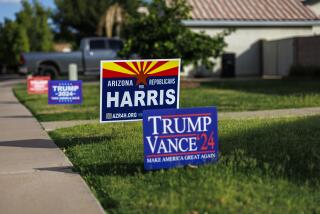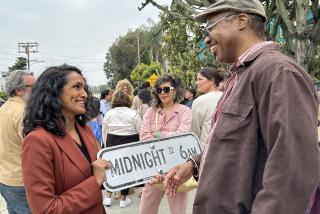Mormon Homosexuals Struggle to Find Acceptance Within Their Faith : Lifestyle: More often, the pressure to conform to the church’s heterosexual ideal fosters hopeless marriages, duplicity, profound guilt, anger and despair.
- Share via
SALT LAKE CITY — Mormons proudly refer to themselves as “a peculiar people,” but the church’s homosexuals might easily claim the designation as their own.
In a religion that champions the family and forbids gay sexual expression, homosexuals seeking a place in the bosom of the faith must remain celibate, or do what most consider is impossible--change their sexual orientation.
More often, the pressure to conform to Mormonism’s heterosexual ideal fosters hopeless marriages, duplicity, profound guilt, anger and despair.
“We are losing so many of them through death to AIDS and to suicide, and lots of people who simply can’t deal with the spiritual, the emotional and the psychic dissonance when a person has to choose between their faith and their being,” said Richard Rees, former bishop of a congregation of unmarried Mormons in Los Angeles, some of whom are gay.
“They deserve our understanding, our love, our acceptance, and they’re not getting it,” Rees said.
The governing First Presidency of The Church of Jesus Christ of Latter-day Saints encourages compassion for transgressors but defines the faith’s moral standard as “abstinence outside of lawful marriage and fidelity within marriage.
“Any other sexual conduct, including fornication, adultery, and homosexual and lesbian behavior, is sinful,” they said in a recent statement.
For decades, Mormon leaders condemned homosexuality as willful perversion, counseled repentance and marriage as an antidote and excommunicated gays unwilling to change.
Since marriage in the faith’s temples is a prerequisite to post-mortal “exhaltation,” many homosexuals lied about their sexuality to escape discipline and to satisfy worthiness requirements for temple attendance.
A minority seeking sexual re-orientation underwent counseling that stressed prayer, fasting and adherence to traditional Mormon goals of serving a two-year mission, marriage and family.
Some homosexuals at Brigham Young University in the 1970s were administered electric shock and vomiting aversion therapies in an effort to “reorient” sexual preference.
Recently, however, church leaders have adopted a slightly more conciliatory stance. Elder Boyd K. Packer acknowledged last year that perhaps members of the hierarchy “don’t really understand these problems.”
The current handbook for bishops condemns “homosexual behavior,” not “homosexuality,” as it once did, and marriage no longer is considered appropriate therapy. Also, strict policies against gays gathering in group therapy or for sports activities have been relaxed.
Still, there remain deep divisions between Mormon gays, their families and the leadership over two fundamental issues: whether homosexuality is innate or learned, and whether homosexual monogamy can find a place in the faith’s theology.
“How do you draw the line between what a person is and what a person does?” asks Rocky O’Donovan, director of the Gay and Lesbian Historical Society. “It’s still homophobia.”
As a youth, O’Donovan made no secret of his homosexual feelings. He was counseled by a church leader not to act on them, but to serve a mission, marry and practice “normal sex.”
“It did not work out because I was gay. I put my ex-wife through four years of hell and it took her two years to recuperate,” said O’Donovan, who recently requested excommunication.
Harold Brown, director of LDS Social Services, said the church continues to assist homosexuals trying to change orientation and believes such therapy is successful in many cases.
“We can’t do a thing about those who say ‘I don’t think I can change and don’t want to change’,” he said. “I’ve seen individuals make that change, and that leaves hope for others.”
If the church’s attitude toward homosexuals has softened over time, Brown said, “it is a shift to care and to understand and to assist,” not to accept gay sex. He said that prohibition would remain intact even if same-sex marriages gained legal sanction.
The American Psychiatric Assn. removed homosexuality from its list of “mental disorders” in 1973 and numerous studies since have pointed to a variety of possible biological causes. But Brown insisted the “most reputable scientists are saying it is still very inconclusive.”
Therapists and others familiar with Mormon homosexuals believe that their numbers are roughly the same as in the general population--about 10%. But that doesn’t mean Mormon gays are as visible within their culture.
“My clinical experience has indicated that the majority of Mormon homosexuals eventually drift away from their faith, live tenuously in the closet, or react with angry disillusionment,” Dr. R. Jan Stout, past president of the Utah Psychiatric Assn., wrote in 1987.
“They ask, ‘Why did God make me this way?’ That question should trouble all of us.”
Paul Mortenson, a founder of Affirmation, a support group for Mormon gays, ran a hotline for seven years from his Los Angeles home and believes far more remain in the closet than have emerged.
In Salt Lake City, O’Donovan said, “there is an enormous number of men who are married to women and go out and practice sex with men, which in this day of AIDS is extremely irresponsible.”
As AIDS and other homosexual issues gain wide exposure, some see a new awareness emerging among Mormons, particularly those with gay family members. They believe that could force the church to re-examine its notions about homosexuality and its theological implications.
“What I see on the horizon is more and more talking about it,” said Marybeth Raynes, a therapist who counsels Mormon gays and lesbians. “I think what is changed in the church is that people are less willing now to just shut up and be quiet and close their doors.”
More to Read
Sign up for Essential California
The most important California stories and recommendations in your inbox every morning.
You may occasionally receive promotional content from the Los Angeles Times.













